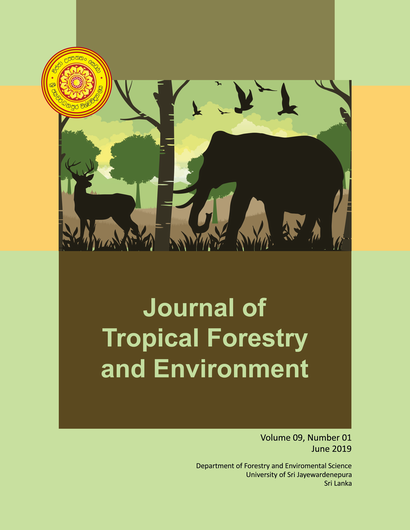Determining the Performance of Plantation Grown Young Santalum album L. with Different Host Species
DOI:
https://doi.org/10.31357/jtfe.v9i1.3946Abstract
Sri Lanka is one of the pioneer countries to adopt the green economy concept and thereby promotes the establishment of forest plantations with the trees of high value. The essential oil produced in the heartwood of Santalum album, native to India, Indonesia and Sri Lanka fetches a very high price and it has been used for perfumery, medicinal, religious and cultural purposes over centuries of years. Due to the over-exploitation, S. album resource in the wild is diminishing and therefore the government implemented strict laws to protect it. Although plantation establishment has been recently started, management became difficult due to lack of technical information. S. album is an obligate hemi-parasite, and obtains certain nutrients from potential host trees via root connections called haustoria. Therefore identifying the most suitable host species in S. album plantation establishment is essential. In order to test the impacts of different host species, a field trial of two hosts per S. album was established and maintained for three years for this study. S. album growth under 21 combinations of six host species including legumes (Acacia auriculiformis, Calliandra calothyrus, Gliricidia sepium, Sesbenia grandiflora) and non-legumes (Coffea arabica, Gravellia robusta) were examined. Height of S. album was measured at two week intervals. Leaf nitrogen, phosphorous, potassium and magnesium of S. album grown with 21 host combinations were also analyzed at regular intervals. Height of S. album was significantly different when planted with different hosts. Calliandra calothyrus was found to be the best host species in increasing height of S. album. It was followed by Acacia auriculiformis and Sesbenia grandiflora. The nitrogen, phosphorus, potassium and magnesium contents of S. album leaves were not significant when planted with the tested host combinations. Therefore the significant height growth of S. album could be caused due to the absorption of water at different levels from different host species.Downloads
Published
2019-08-03
How to Cite
Subasinghe, S., Millaniyage, K., & Hettiarachchi, D. (2019). Determining the Performance of Plantation Grown Young Santalum album L. with Different Host Species. Journal of Tropical Forestry and Environment, 9(1). https://doi.org/10.31357/jtfe.v9i1.3946
Issue
Section
Articles
License
The publisher retain the copyrights of contents published, and all open access articles are distributed under the terms of the Creative Commons Attribution-Noncommercial-No Derivative Works 3.0 Unported License[U1], which permits unrestricted use, distribution and reproduction in any medium, provided that the original work is properly cited.
You can download the Legal Code for this License at: http://creativecommons.org/licenses/by-nc-nd/3.0/legalcode


